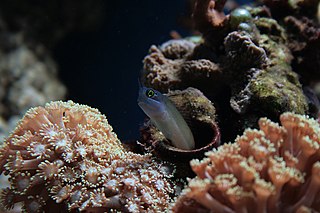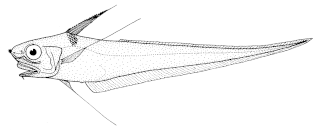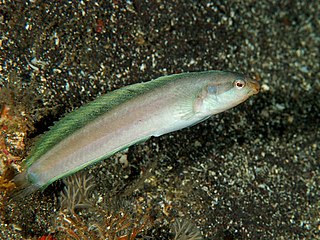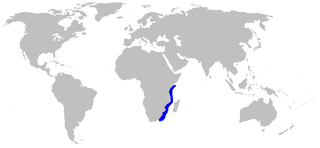 W
WAspidoras fuscoguttatus is a tropical freshwater fish belonging to the Corydoradinae sub-family of the family Callichthyidae. It originates in inland waters in South America, and is found in the upper Paraná River basin in Brazil and Peru.
 W
WThe Caribbean chestnut moray, Enchelycore carychroa, is a moray eel of the family Muraenidae, found in the western Atlantic from Bermuda, southern Florida, the Bahamas, and the western Gulf of Mexico to Brazil, at depths between 1 and 20 m. Their length is up to 34 cm, or just over 1 ft, making them the smallest members of their genus and among the smaller morays.
 W
WChaetodontoplus caeruleopunctatus is a marine angelfish from the Western-Pacific Ocean. It occasionally makes its way into the aquarium trade. It grows to a size of 14 cm in length. It may eat at soft corals, stony corals, and mantles of tridacnid clams.
 W
WChaetodontoplus mesoleucus, also known as the Red Sea butterflyfish is a member of the family Pomacanthidae.
 W
WChiloglanis carnosus is a species of upside-down catfish endemic to the Democratic Republic of the Congo where it occurs in rapids of the lower Congo River. This species grows to a length of 6.1 centimetres (2.4 in) TL.
 W
WChrysiptera springeri is a species of damselfish known by the common name Springer's demoiselle. It is native to the western Pacific Ocean, where it occurs in the tropical waters of Indonesia and the Philippines. It reaches 5.5 centimeters in length and is variable in color. The specific name honours the ichthyologist Victor G. Springer who collected the type in the Moluccas.
 W
WCirrisalarias bunares, the hairy blenny or medusa blenny, is a species of combtooth blenny found in the western central Pacific and Indian Oceans. This species is the only known member of its genus.
 W
WCynotilapia axelrodi is a species haplochromine cichlid which is endemic to Lake Malawi where it occurs in Nkhata Bay and Chirombo Point, Malawi. The specific name honours the publisher Herbert R. Axelrod (1927-2017).
 W
WEcsenius melarchus, known commonly as the yellow-eyed comb-tooth or the Java combtooth-blenny in Indonesia, is a species of combtooth blenny in the genus Ecsenius. It is found in coral reefs in the western Pacific ocean. It can reach a maximum length of 5 centimetres. Blennies in this species primarily feed off of plants, including benthic algae and weeds, and are commercial aquarium fish. The specific name "melarchus" is Latin for "black anus", and refers to the black anal marking on the blennies in this species.
 W
WEcsenius pictus, known commonly as the white-lined comb-tooth in Indonesia and the pictus blenny in Micronesia, is a species of combtooth blenny family Blenniidae.
 W
WEcsenius schroederi, known commonly as the Schroeder's combtooth-blenny in Indonesia, is a species of combtooth blenny in the genus Ecsenius. It is found in coral reefs in the western Pacific ocean, specifically in Indonesia. It can reach a maximum length of 7 centimetres. Blennies in this species feed primarily off of plants, including benthic algae and weeds, and are commercial aquarium fish. The species was named in honour of the wildlife artist and scientific illustrator Jack R. Schroeder (1954-2004).
 W
WGymnallabes nops, popularly known as the blind eel catfish, is a species of airbreathing catfish found in the lower Congo River basin in the countries of the Democratic Republic of the Congo and the Republic of the Congo. It is blind, non-pigmented and grows to a length of 5.7 cm (2.2 in) SL.
 W
WKottelatia brittani is a species of cyprinid fish that occurs in the Southeast Asian nations of Indonesia and Malaysia. It is the only species recognized in its genus.
 W
WThe long-rayed whiptail or four-rayed rattail, Coryphaenoides subserrulatus, is a rattail of the genus Coryphaenoides, found circumpolar in all southern oceans, at depths between 550 and 1,200 m. Its length is between 20 and 37 cm.
 W
WMaylandia fainzilberi is a species of cichlid endemic to Lake Malawi. It can reach a length of 12.9 centimetres (5.1 in) TL. It can also be found in the aquarium trade. The honours the tropical fish dealer Misha Fainzilber who helped the author, Wolfgang Staeck, gain access to Lake Malawi.
 W
WNeoraja caerulea, also known as the blue ray or blue pygmy skate, is a species of fish in the family Rajidae. This small ray reaches a total length of approximately fish 30 centimetres (12 in) and is endemic to the north-eastern Atlantic Ocean off Ireland and Iceland, and south to the Bay of Biscay. It occurs at depths of 600 to 1,262 metres.
 W
WParupeneus forsskali, common name Red Sea goatfish, is a species of goatfish belonging to the family Mullidae.
 W
WPetroscirtes fallax, the deceiver fangbelly or yellow saberetooth blenny, is a species of combtooth blenny found in coral reefs in the western Pacific ocean. This species reaches a length of 9.5 centimetres (3.7 in) TL. This is a small species of blenny with a body which is yellow to whitish in colour and is marked with three longitudinal black stripes. The more ventral stripe extending onto the base of the pectoral fin although not to the base of the anal fin. This species is thought to be a possible Batesian mimic of the Lined Fangblenny, Meiacanthus lineatus, which has a pair of venomous canine-like teeth in its lower jaw.
 W
WPetroscirtes springeri is a species of combtooth blenny found in coral reefs in the northwest Pacific ocean. This species reaches a length of 7.7 centimetres (3.0 in) SL. The specific name honours the American ichthyologist Victor G. Springer of the United States National Museum, it was Springer who first introduced the author to the blenniids and who suggested the study in which Smith-Vaniz described this species.
 W
WPinchuk's goby is a species of goby native to the Black Sea and the Sea of Azov.
 W
WPlagiotremus phenax, the Imposter fangblenny, is a species of combtooth blenny found in coral reefs in the Indian ocean. This species reaches a length of 8 centimetres (3.1 in) TL. This blenny uses bio mimicry to avoid predation, as it has a strong resemblance to the disco blenny.
 W
WSladenia shaefersi is a species of fish in the family Lophiidae. It also commonly goes by the name of Shaefer's anglerfish. It was first discovered in the Caribbean Sea off the coast of Colombia and was described in 1976.
 W
WThe small-spine tadpole-goby is a species of goby, a small fish native to the eastern coasts of the Caspian Sea and the lower reaches of the Volga River up to Volgograd. In the sea it is recorded from the Cape Peschany to the Çeleken Peninsula and Ogurja Ada Island in the south. It is abundant the Volga River delta. This species can be found at depths down to 50 metres (160 ft) although the adults generally are not found deeper than 11 metres (36 ft). This species can reach a length of 6.6 centimetres (2.6 in) TL. The specific name honours the Azerbaijani ichthyologist A. A. Mahmudbekov, studied the fish of the Caspian Sea for much of his life.
 W
WThe snail darter is a small species of freshwater ray-finned fish, a darter from the subfamily Etheostomatinae, part of the family Percidae, which also contains the perches, ruffes and pikeperches. It is found in East Tennessee freshwater in the United States. First recorded in 1973, the snail darter was listed as endangered under the U.S. Endangered Species Act of 1973 by 1975 and was involved in a legal controversy leading to a Supreme Court ruling to halt the completion of Tellico Dam, which posed a risk of extinction for the snail darter by blocking its migratory route — see Tennessee Valley Authority v. Hill, snail darter controversy.
 W
WSpeleogobius trigloides, also known as the Grotto goby, is a species of goby native to the Mediterranean Sea where it is known to inhabit grottoes at depths of from 8 to 25 metres. This species grows to a length of 1.8 centimetres (0.71 in) SL.
 W
WSundadanio axelrodi is a danionin in the family Cyprinidae. Originally described as a rasbora, Rasbora axelrodi, this tiny species was later deemed to be more closely related to the danios but not enough to be moved into the genus Danio. Sundadanio axelrodi reaches a maximum size of 1.7 cm. Sundadanio was considered monotypic until the genus was reassessed by Conway, Kottelat and Tan in 2011.
 W
WThe thorny lanternshark is a shark of the family Etmopteridae found in the western Indian Ocean between latitudes 0° and 31°S, at depths between 200 and 500 m. Its length is up to 27 cm.